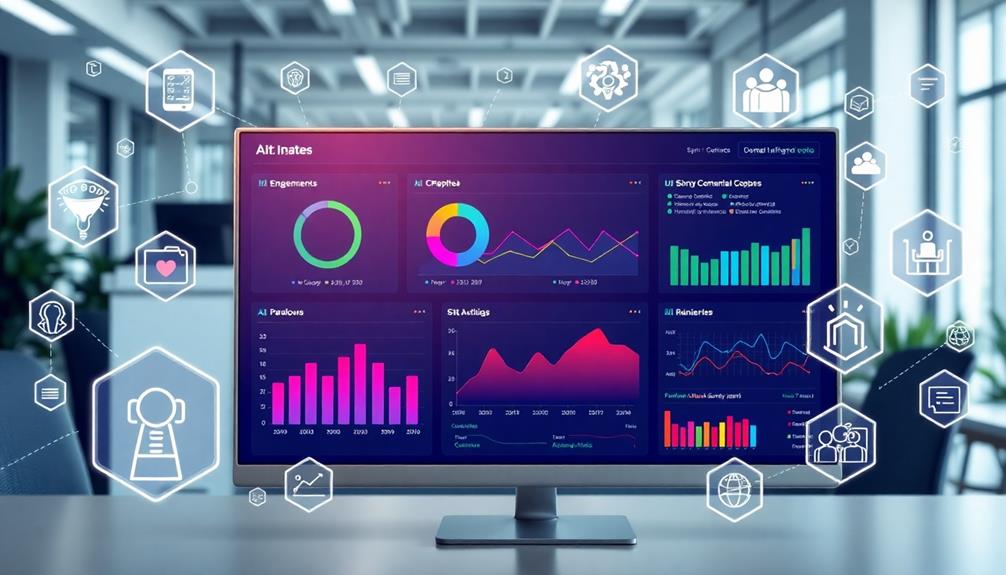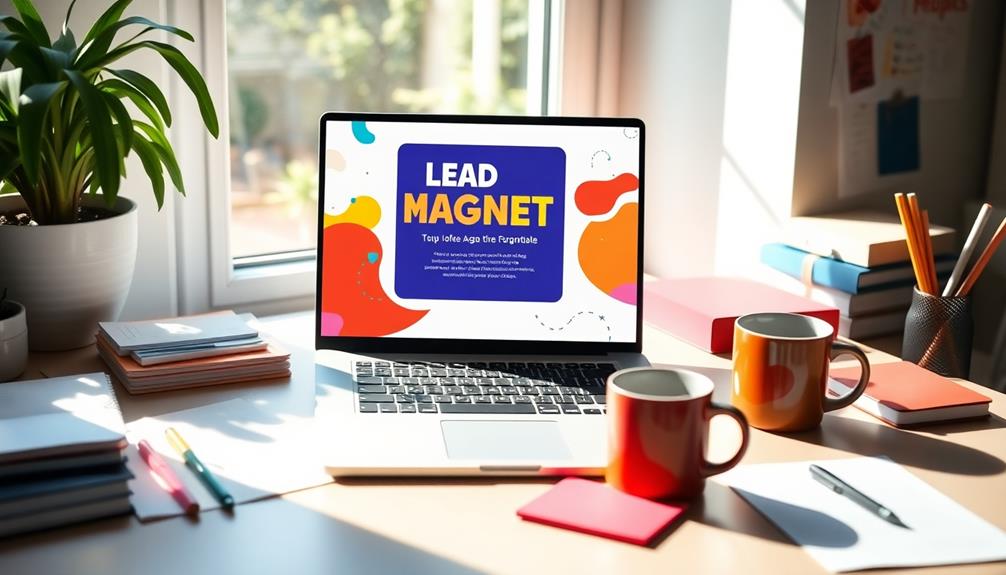To boost your marketing results, there are ten key metrics AI can help you track. Keep an eye on engagement rates to measure audience interest and click-through rates (CTR) to evaluate content effectiveness. Understanding your audience demographics enhances targeting, while tracking conversion rates shows how well you're driving desired actions. Customer lifetime value and churn rates give insights into retention and profitability. Don't forget about brand sentiment analysis and social media interactions to gauge public perception. Finally, understanding website traffic sources can inform your strategy. There's much more to uncover about maximizing these metrics!
Key Takeaways
- AI enhances engagement rates by analyzing likes, shares, and comments, leading to increased customer interactions and revenue growth.
- Click-through rates (CTR) are optimized through AI analysis of historical data, improving the effectiveness of marketing campaigns.
- Audience demographics and real-time insights are refined using AI, ensuring targeted marketing strategies resonate with the right consumers.
- Conversion rates and customer lifetime value (CLV) benefit from AI-driven analytics, leading to improved marketing ROI and customer retention.
- Brand sentiment analysis through AI helps track consumer feelings, enabling adjustments to marketing strategies based on feedback and trends.
Engagement Rates
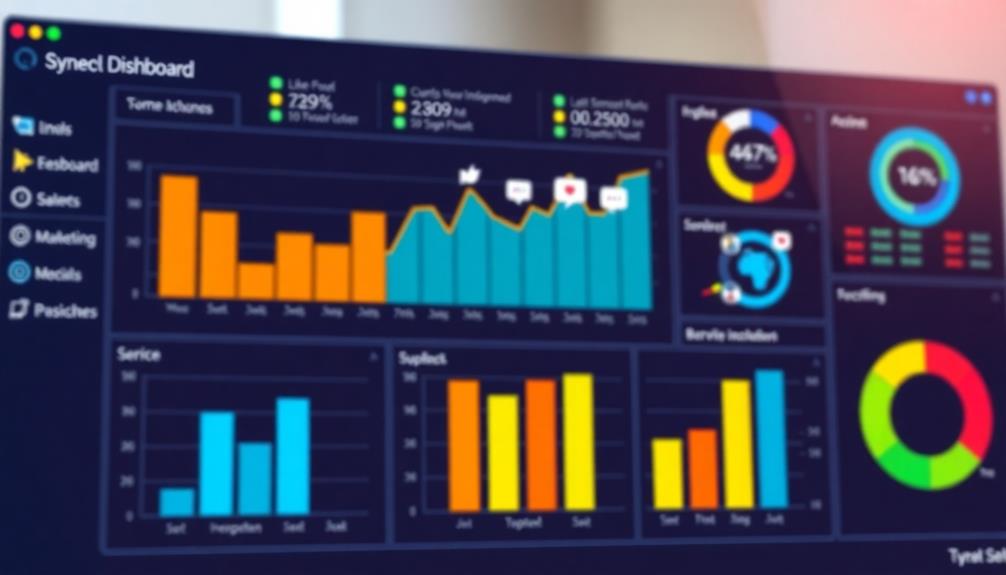
While you may already know that engagement rates are essential for gauging content effectiveness, it's important to understand how they directly influence your marketing success. Engagement metrics like likes, shares, comments, and click-throughs reflect audience interest and can greatly impact your strategy.
In fact, content with higher engagement rates can lead to a staggering 74% increase in customer interactions.
By leveraging AI tools, you can analyze these engagement trends over time, pinpointing which content types resonate most with your audience. This not only helps you refine your content strategies but also guarantees that you're creating material that truly engages your customers.
With real-time data at your fingertips, you can make quick adjustments to your marketing campaigns, enhancing your responsiveness to audience behavior and preferences.
Moreover, businesses that utilize AI-driven insights for tracking engagement often report improved performance metrics. Some brands even experience a remarkable 115% revenue growth directly linked to effective engagement strategies.
Conversion Rates
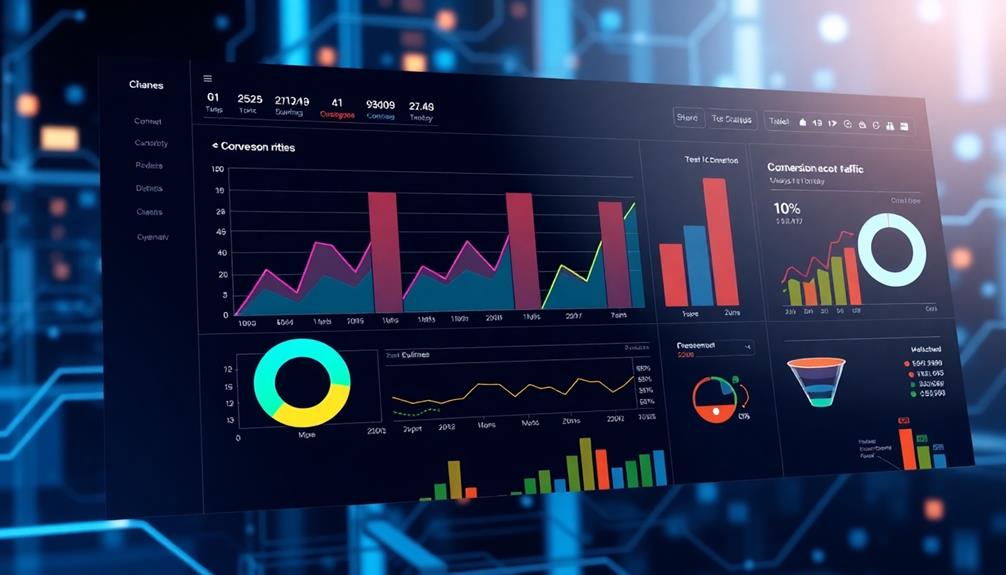
Understanding conversion rates is essential for any marketer aiming to evaluate the effectiveness of their strategies. Conversion rates measure the percentage of users who take desired actions, like making a purchase or signing up for a newsletter.
By implementing AI-driven analytics, you can gain deeper insights into customer behavior, enhancing the accuracy of your conversion rate tracking. With advancements in technology, such as AI privacy solutions, marketers can now analyze user data while ensuring compliance with privacy regulations.
AI tools analyze user patterns and identify factors influencing decision-making, allowing you to optimize your marketing efforts. Using predictive analytics, you can forecast future conversion trends based on historical data, enabling proactive strategy adjustments that maximize results.
For instance, effective utilization of AI in analyzing conversion rates can lead to a staggering 15% improvement in marketing ROI.
Real-time monitoring through AI tools lets you make immediate adjustments to your campaigns, ensuring they align with current consumer behaviors and preferences.
Audience Demographics
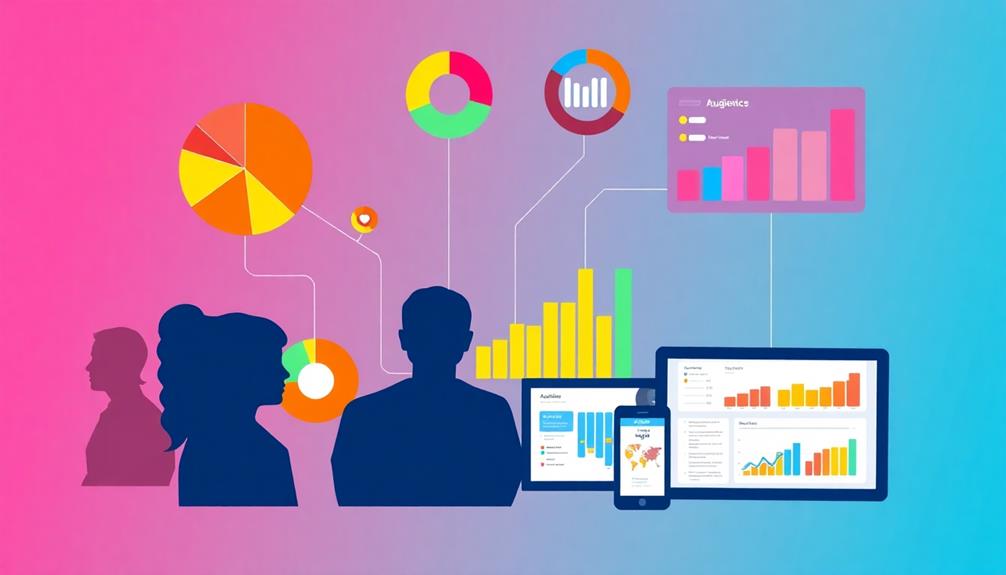
Understanding audience demographics gives you real-time insights that can transform your marketing approach.
By employing AI, you can enhance your targeting strategies, ensuring your campaigns resonate with the right groups at the right time.
This level of precision helps you adapt quickly to shifts in audience behavior and preferences.
Real-Time Audience Insights
Accessing real-time audience insights is essential for today's marketers looking to stay ahead of the game. With AI tools at your disposal, you can analyze vast amounts of demographic data instantly, enabling you to understand your target audiences better than ever before. This is particularly important as startups often face challenges in identifying and connecting with their customers, as highlighted in various startup stories.
Traditional methods often leave marketers dissatisfied, but AI-driven insights offer a fresh perspective on audience interests and engagement.
By leveraging machine learning algorithms, you can identify patterns and trends that inform your strategies. These insights allow you to make data-driven decisions that resonate with your audience, enhancing the effectiveness of your campaigns.
AI tools also enable dynamic audience segmentation, updating demographic insights in real-time. This means you can adjust your messaging on the fly, ensuring that you're speaking directly to the needs and preferences of your audience.
The result? Hyper-personalization that improves overall engagement by approximately 74%. When you understand your audience's demographics in real-time, you can tailor your marketing efforts to create meaningful connections.
In a fast-paced digital landscape, staying agile and informed is key to achieving your marketing goals. Embrace real-time audience insights, and watch your campaigns thrive.
Enhanced Targeting Strategies
With AI at your fingertips, enhancing targeting strategies becomes a game-changer for marketers. By analyzing vast datasets, AI identifies consumer behavior patterns that go beyond traditional demographics, allowing for more precise segmentation. This includes addressing AI security vulnerabilities that could impact data integrity, ensuring your campaigns are built on reliable insights. This means you can tailor your campaigns to specific audience segments, improving overall audience engagement.
Machine learning algorithms dynamically update audience insights in real-time, enabling you to adapt your campaigns based on current trends and preferences. Tracking user behavior through marketing metrics, such as click-through rates and session duration, helps refine your targeting strategies, ensuring your efforts are effective.
Moreover, AI-driven predictive analytics allows you to forecast future audience behaviors. This foresight enables proactive adjustments to your marketing tactics, aligning them with evolving consumer interests. A study found that brands leveraging AI for audience analysis reported remarkable results, like a 120% increase in clicks and a 117% increase in purchases.
Incorporating AI into your marketing strategy not only enhances targeting strategies but also greatly boosts your campaign's effectiveness, driving better results in audience engagement and overall performance.
Customer Lifetime Value

Customer Lifetime Value (CLV) plays an essential role in helping businesses gauge the total revenue they can anticipate from a single customer over their relationship. By understanding CLV, you can tailor your marketing efforts to maximize profitability.
AI enhances CLV calculations by analyzing historical purchase data and predicting future buying behaviors, allowing for more accurate assessments of customer value.
Investing in customer retention strategies can greatly boost CLV—research shows it can increase by up to 95%. With AI-driven segmentation, you can identify high-value customers and create personalized marketing campaigns that resonate with them. This targeted approach can lead to a 10-30% increase in CLV.
Moreover, by utilizing machine learning algorithms, you can continuously refine your CLV models, ensuring your marketing efforts align with real-time customer behavior and preferences. This adaptability is vital in today's fast-paced market, where customer needs change frequently.
Incorporating CLV into your marketing strategy not only helps you understand your customers better but also drives long-term business growth and sustainability. Ultimately, focusing on CLV means you're investing in relationships that yield the highest returns.
Click-Through Rates

Understanding Customer Lifetime Value (CLV) sets the stage for optimizing your marketing campaigns, particularly when it comes to measuring Click-Through Rates (CTR).
CTR measures the percentage of users who click on a specific link compared to the total number of users who view a page, email, or advertisement. A high CTR indicates your content resonates with the audience, while average CTRs vary—email marketing sees around 1-5% and display ads hover at 0.05-0.10%.
To boost your CTR, consider leveraging AI tools. These tools can analyze historical CTR data, identifying patterns that enable you to make data-driven decisions.
By using machine learning algorithms, you can dynamically adjust content and targeting strategies in real-time, enhancing engagement and improving overall campaign performance.
Moreover, personalization is key. When you tailor messages based on individual user behaviors and preferences, you can increase CTR by up to 74%.
This means that understanding your audience isn't just beneficial; it's essential. By focusing on click-through rates and utilizing AI for optimization and personalization, you're on your way to achieving better marketing results.
Return on Advertising Spend
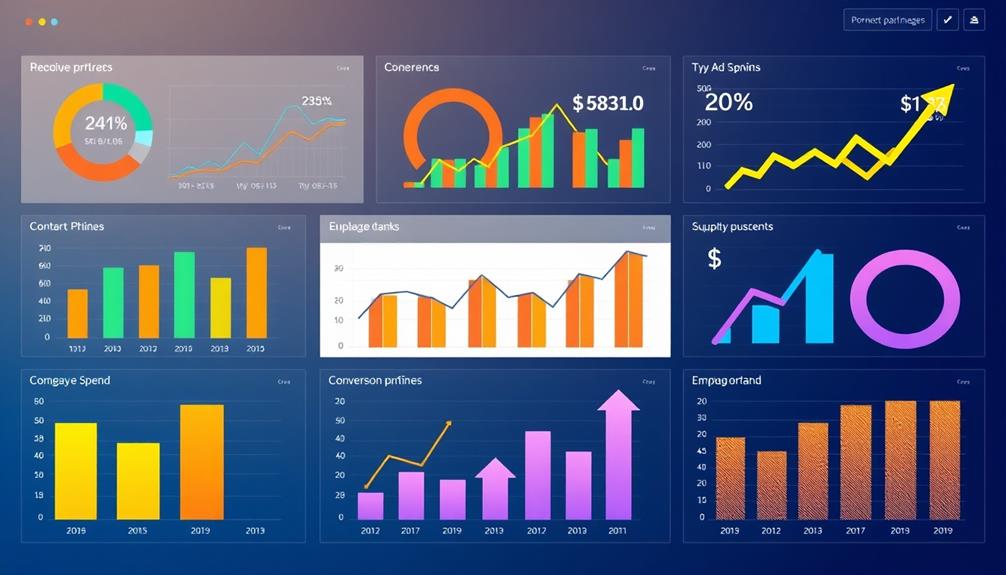
When you measure Return on Advertising Spend (ROAS), you're evaluating how effectively your ad dollars are generating revenue.
By optimizing your ad spend allocation, you can focus on the channels that deliver the best results.
With the right metrics in place, you can greatly enhance your advertising strategies and boost your overall marketing effectiveness.
Measuring Advertising Effectiveness
Measuring advertising effectiveness often hinges on Return on Advertising Spend (ROAS), an important metric that reveals how much revenue you generate for each dollar spent on ads. A well-optimized ROAS not only shows the profitability of your marketing campaigns but also helps you gauge whether you're on track for sustainable growth.
Aim for a target ROAS of at least 4:1 to guarantee your efforts are paying off.
Utilizing AI tools can greatly enhance your understanding of ROAS by analyzing historical advertising data to forecast future outcomes. This insight allows you to make informed decisions about budget allocation and campaign strategies.
By employing machine learning algorithms, you can identify which ad placements and creatives yield the highest ROAS. This targeted approach enhances your overall advertising effectiveness.
Moreover, continuous tracking of ROAS through AI-driven analytics empowers you to make real-time adjustments to your campaigns. By maximizing performance and minimizing wasted ad spend, you can optimize your advertising efforts to achieve better results.
In this rapidly evolving digital landscape, leveraging these metrics is vital to stay ahead of the competition and enhance your marketing effectiveness.
Optimizing Ad Spend Allocation
Optimizing ad spend allocation is vital for maximizing your Return on Advertising Spend (ROAS). By leveraging AI, you can analyze historical ad performance data to allocate your budgets more effectively. This means identifying the most profitable channels and campaigns that deliver results.
Machine learning algorithms can predict future ad performance based on past trends, allowing you to adjust your spending proactively. This not only increases overall campaign efficiency but also guarantees that your marketing budgets are directed toward high-performing ads.
Real-time data processing gives you valuable insights, minimizing waste on underperforming ads. Continuously monitoring and analyzing key performance metrics lets AI help you reallocate funds dynamically during a campaign.
This adaptability maximizes your ROAS by focusing on current audience engagement and market conditions. Companies using AI for ad spend optimization have reported up to a 30% increase in ROAS, thanks to data-driven insights that inform budget decisions.
In today's competitive landscape, effective ad spend allocation is essential. By integrating AI into your marketing strategy, you can make certain that every dollar spent contributes to the best results.
Embrace these tools to enhance your advertising effectiveness and drive better outcomes.
Churn Rates
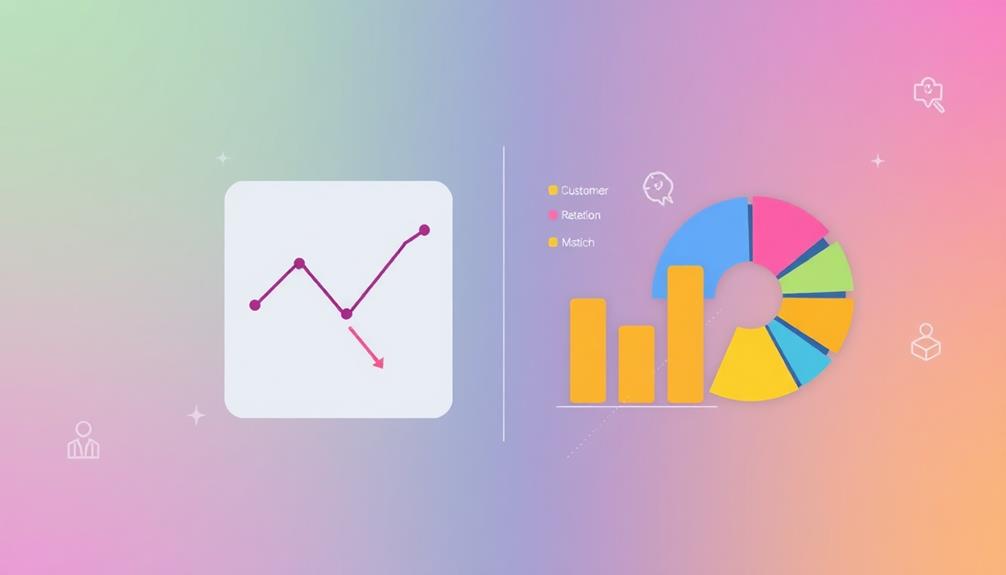
Understanding churn rates is essential for any business that relies on customer retention, as it reflects the percentage of customers who discontinue using a service over a specific timeframe. For instance, SaaS companies typically experience an average churn rate of 5% to 7% annually, while subscription-based businesses can see rates soar above 20%. Recognizing these figures helps you gauge customer satisfaction and loyalty effectively.
Utilizing AI analytics can remarkably enhance your understanding of churn. By identifying patterns in customer behavior—like decreased engagement or transaction frequency—you can develop proactive retention strategies that address issues before they escalate. Reducing churn by just 5% can boost your profits by an impressive 25% to 95%, underscoring the financial importance of managing churn effectively.
Moreover, leveraging AI tools allows you to create personalized customer interactions that resonate with your audience. When customers feel valued and understood, their likelihood of staying loyal increases remarkably.
Brand Sentiment Analysis
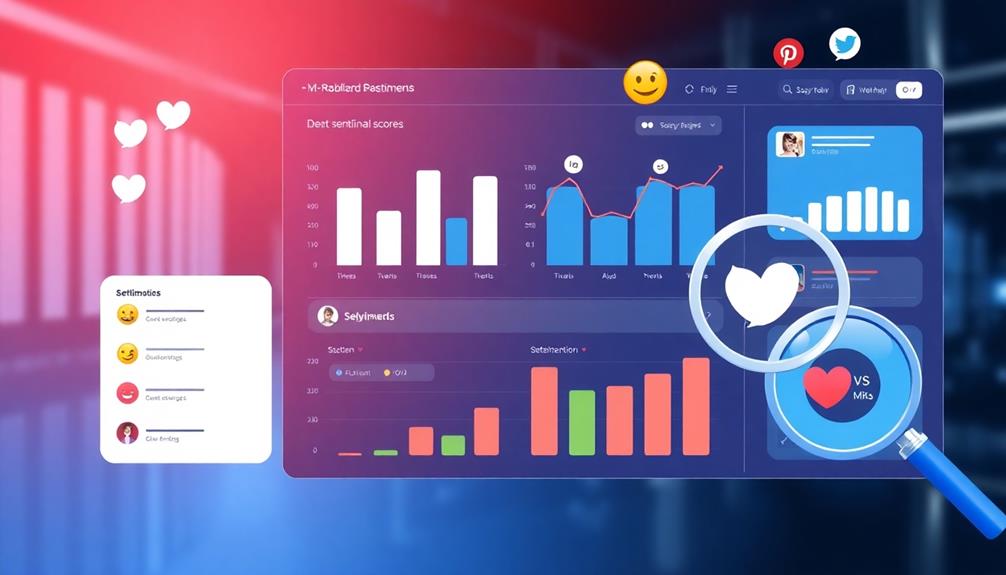
Brand sentiment analysis is a powerful tool that leverages AI to evaluate how consumers feel about your brand by analyzing social media posts, reviews, and other online content. This process is vital for understanding public perception and can greatly influence brand awareness and customer experience.
By utilizing AI platforms and natural language processing (NLP), you can classify sentiments as positive, negative, or neutral, allowing you to quickly gauge reactions and adjust your marketing strategies.
Here are some key benefits to keep in mind:
- Improved Customer Loyalty: Companies using sentiment analysis can enhance engagement, as 68% of consumers might switch to competitors after a negative experience.
- Informed Decision-Making: Monitoring sentiment trends enables marketing leaders to refine strategies based on real-time feedback.
- Impact Assessment: Tracking sentiment over time helps you analyze the effectiveness of marketing campaigns and product launches.
With studies showing that 70% of consumers are influenced by online reviews, implementing sentiment analysis is essential for effective brand reputation management.
Social Media Interactions

When you analyze engagement rates on social media, you can uncover what content truly resonates with your audience.
Tracking performance metrics helps you understand which posts drive the most interaction, allowing you to refine your strategy.
Engagement Rate Analysis
Engagement rate analysis serves as an essential indicator of how well your content resonates with your audience on social media. By measuring interactions like likes, shares, and comments against your total followers or impressions, you gain valuable insights into audience interest and content effectiveness.
A high engagement rate typically means your posts are connecting, leading to 50% higher reach compared to lower-engagement content.
Consider the following points to enhance your engagement rate:
- Real-time insights: AI tools can analyze engagement data instantly, allowing you to adapt your content strategies quickly.
- Target high-engagement content: Regularly tracking your engagement rates helps identify which content types resonate best with your audience.
- Boost performance metrics: Brands with strong engagement can see up to 120% more clicks and 117% more purchases, emphasizing the need for effective engagement strategies.
Content Performance Metrics
Measuring social media interactions is essential for understanding how your content performs and connects with your audience. These interactions, including likes, shares, and comments, serve as critical content performance metrics that reflect user engagement. By analyzing this data, you can gauge your brand's visibility and reputation effectively.
Utilizing AI-driven insights can greatly enhance your approach. Studies show that posts optimized with these insights can achieve up to 120% more engagement. With AI tools, you can track social media interaction patterns in real-time, allowing you to adjust your strategies quickly based on what resonates with your audience.
Metrics like engagement rate and share of voice become more informative through AI analytics, providing deeper insights into how your content appeals to target demographics.
Plus, AI automates tracking across multiple platforms, consolidating data for a thorough performance analysis. This capability enables you to make more effective campaign adjustments, ensuring your content continues to engage and connect with your audience.
Incorporating these content performance metrics into your marketing strategy won't only improve engagement but also foster stronger audience loyalty.
Website Traffic Sources
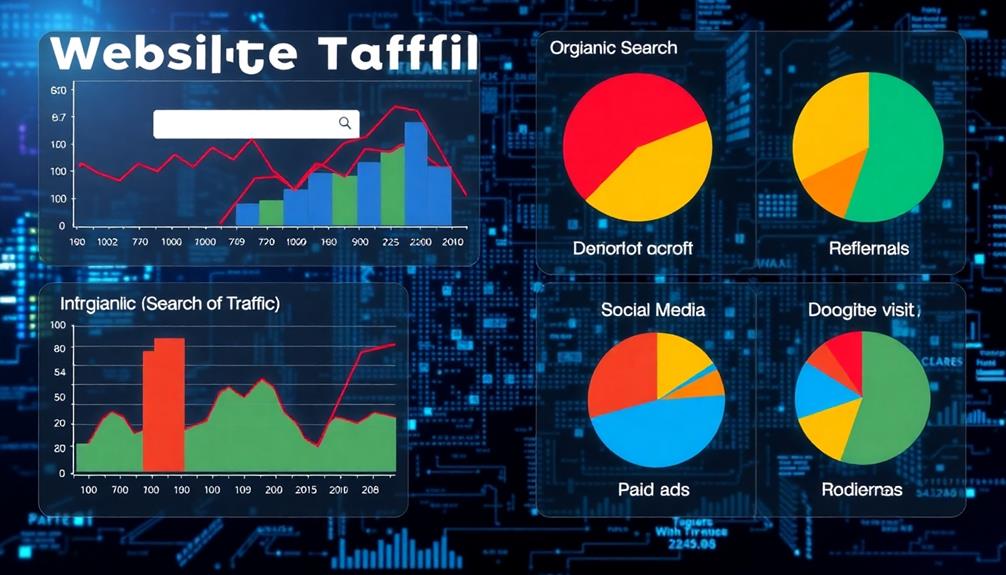
Understanding website traffic sources is essential for effective marketing, as they reveal how visitors find your site. By identifying where your users come from, you can fine-tune your strategies and drive more targeted traffic. For instance, 51% of your traffic likely comes from organic search, emphasizing the need for a solid SEO focus.
Consider these key sources:
- Referral traffic: Accounts for about 25% of visits, showcasing the significance of partnerships and backlinks.
- Social media: Contributes around 15%, highlighting the necessity for engaging social strategies.
- Email marketing: Generates an impressive ROI, with $42 earned for every $1 spent, making targeted campaigns essential.
Using metrics from tools like Google Analytics, you'll discover that over 50% of users access your site via mobile devices. This insight shows why mobile optimization is important.
Plus, AI enables you to analyze this data more effectively, helping you adapt your marketing efforts to the channels that matter most. By focusing on these traffic sources, you can enhance visibility and engagement, ultimately driving better marketing results.
Frequently Asked Questions
How Does AI Analyze Sentiment From Customer Reviews?
AI analyzes sentiment from customer reviews by processing text, identifying keywords, and evaluating emotional tone. It categorizes feedback as positive, negative, or neutral, allowing you to understand customer feelings and improve your products or services accordingly.
Can AI Predict Future Marketing Trends Based on Current Data?
Sure, AI's got a crystal ball, right? It can spot trends faster than you can say "data overload." By analyzing current patterns, it predicts future marketing moves, helping you stay ahead while sipping your coffee.
What Tools Are Best for Tracking These Metrics With AI?
To track marketing metrics effectively, you'll want tools like Google Analytics, HubSpot, or Tableau. These platforms use AI to analyze data, providing insights to optimize your campaigns and boost overall performance.
How Can AI Help Optimize Ad Targeting for Specific Demographics?
Imagine a skilled archer, honing their aim. AI sharpens your ad targeting, analyzing demographics like a master craftsman. It identifies patterns, ensuring your message hits the right audience, maximizing engagement, and boosting conversion rates effectively.
What Are the Limitations of Using AI for Marketing Metrics?
AI's limitations in marketing metrics include data accuracy, bias in algorithms, and over-reliance on historical data. You can't overlook human intuition and creativity, which remain essential for effective marketing strategies despite AI's capabilities.
Conclusion
By leveraging these 10 metrics, you can access the full potential of your marketing strategy. Imagine turning insights into actions that resonate with your audience, driving engagement and boosting conversions. You're not just tracking numbers; you're shaping the future of your brand. So, why leave success to chance? Embrace AI's capabilities to refine your approach and watch your marketing results soar. The power to transform your strategy is right at your fingertips—don't let it slip away!

